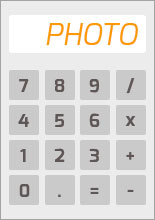Tips for calculating
1. Marketing your photo exhibition
There are theories which say that it is not the best artists that become most famous but rather the ones that market themselves best. And it’s true that all the talent in the world means little if the public doesn’t get to know it – at least in an economic sense. However, there is good news for artists: for good photography, you need talent. Good marketing can be learned.
Posters Poster advertising truly is one of the classic forms of cultural advertising. With their spectacular designs from various epochs, the posters from long past exhibitions are collectors’ items once again and today are the objects themselves of successful exhibitions. Posters are so much a part of an exhibition these days that an exhibition without posters might be regarded as being something less than professional. Posters can be produced very cheaply these days.
Flyers/postcards These are the smaller, cheaper supplement to posters. They can be placed anywhere and everywhere where it may not be possible to hang a poster. But they should not be though of as being an alternative to posters unless there really is not other way to market the photo exhibition. Flyers and postcards can also be ordered cheaply from online printing services.
Invitation cards The invitation card is also a classic instrument of cultural marketing. It is a tool for direct marketing, is very personal and is directed to your favoured contacts. To work successfully with invitation cards, you will need a top-grade address list, which you will ideally have put together over the course the years.
Outside advertising/banner Banners fulfil two central functions: the temporary hanging of the banner provides the exhibition with a certain event character and is, at the same time, a signpost for your visitors. When the motif of the invitation cards and banner are coordinated, visitors will be able to already see from far away that they have arrived at the right place. The possibility of hanging a banner must, however, be discussed in advanced with the owners of the venue.
2. The images
Production The production of a photo exhibition is an important component of the entire project. After all, the photography appearing on the chosen media is the main star of the exhibition. The images were selected with great care and are now, after much consideration, the motif for the photo exhibition. The choice of medium is decisive for how the exhibition visitors, the customers, will perceive the images. Basically, the following applies: the quality of the production corresponds to the value perceived by the viewer..
Frames Until a few years ago, it was usual to have images hung without frames, in order to allow the image to speak for itself. High-quality processing such as premium composites exuded the feeling of durable high value. Today, many exhibits for photo exhibitions are framed. This, though, raises the costs of production considerably – framing can double the costs for picture production.
Mounting The topic of mounting is frequently underestimated. Depending on the circumstances, a practical solution must be found for the photo exhibition, which will not impede the planned sale of the pieces. These solutions can add up to an extra 30% of production costs. .
3. The exhibition venue
The right choice of exhibition venue is frequently underestimated by artists. Usually, a variety of locations are scouted and then the various alternatives are weighed against each other, but the real challenges are often overseen. In many cases, the artist looks for the possibility of exhibiting his/her works in the nearby vicinity instead of allowing the relevant sale market to lead the decision. The decisive question is therefore: will it draw my target group?

